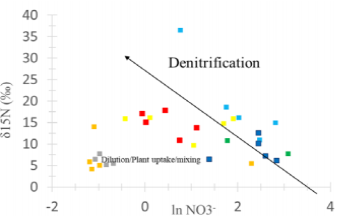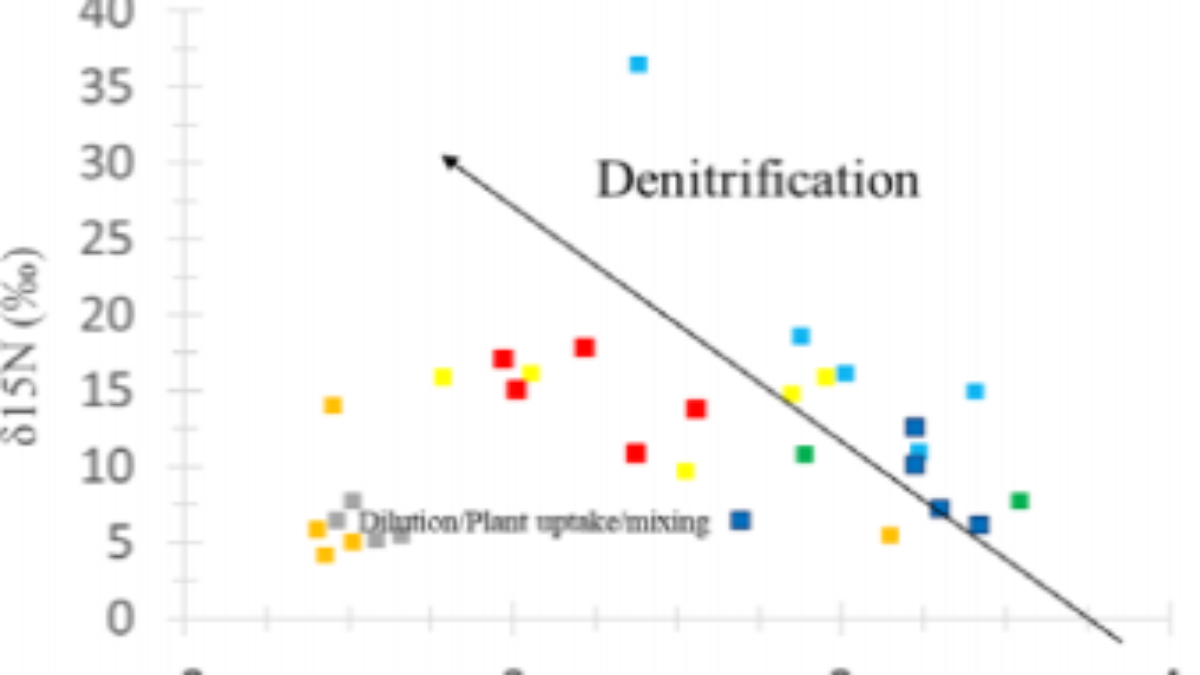DR. ERIC W. PETERSON, ILLINOIS STATE UNIVERSITY

Introduction:
Agriculture is acknowledged as a leading cause of surface water pollution [1, 2], serving as the principal source of nitrogen (N), primarily nitrate (NO3), to aquatic environments [3-6]. Hypoxia, eutrophication, and biodiversity changes within surface waters, specifically the Gulf of Mexico, are attributed to excess NO3 loading [7-10]. On an annual basis in the US Midwest, an estimated 1 million metric tons of N is leached from the agricultural fields into waters of the Mississippi River [11]. Since 1950, the NO3 load discharged into the Gulf of Mexico has tripled [9, 12]. Illinois has been identified as the second leading contributor of
NO3, with Illinoisan agricultural activity contributing 19% of the NO3 load delivered to the Mississippi River [13-16].
Research Objectives:
1) Identify the flowpath of the waters traveling from the diversion tiles to the stream.
2) Measure the travel time for the waters along the flowpath to the stream, i.e. what is the residence time of the waters in the SBZ? Preliminary calculations using Darcy’s Law suggest a travel time from the eastern diversion tile to well 6 of approximately 51 days.
3) Calculate the amount of dilution using a mixing model.
Methodology:
A tracer test will be conducted to address the question and objectives. Sodium bromide (NaBr) will be introduced into the tile-diversion box. NaBr was chosen because the measured background concentrations of Br- have consistently been below 0.5 mg/L. Prior to the initiation of the test and once every two weeks over 22 weeks, waters from 20 wells (not 14 or 15), the diversion box, and the stream will be collected and analyzed.
Expected Outcomes:
Agricultural runoff diversion into SBZ may be a potential best management practice (BMP) to reduce NO3 in tile-drained waters. Outcomes from this project will further address the source of reduction, dilution or removal (denitrification or assimilation). The project will be considered successful if (1) travel times for the waters from the diversion tile to the wells are quantified, (2) a graduate student is trained in field and laboratory techniques, (3) a MS thesis has been completed, (4) presentations by students at an Illinois Water conference, an Illinois Groundwater Association meeting, and the annual Geological Society of America meeting, and a peer-reviewed publication have been completed. These results represent baseline data necessary to support all future research activities and develop appropriate BMPs for NO3-N applications.
Project Impact:
The project was undertaken to quantify the travel times of waters introduced into a saturated buffer zone (SBZ), which would allow for the calculation of the nitrate reduction within the system. SBZs are a possible best management practice that can be employed to intercept tile drainage water prior to discharge in streams. While the utility of SBZ is not in question, studies have shown that denitrification and plant uptake are removal mechanisms, understanding the travel time (distances) that are needed for the SBZ systems to be effective is not well documented. This work was an attempt to provide data and insight to address this knowledge gap. The results from the tracer test 1) quantified the travel times for waters in a saturated buffer zone situated in glacial materials. The initial calculations conducted prior to the test suggested a travel time of approximately 70 days. After the tracer injection, the down gradient wells had their peak tracer concentrations at 13-15 days, which was the result of a higher than anticipated hydraulic gradient. Despite the shorter time, the data showed that between 38% to 100% of the nitrate introduced from the tile drainage system was removed along the travel path. As the observation wells were different distances from the diversion tile, the results had a linear relationship between distance (time) traveled and nitrate reduction. These data can be used to help develop SBZ system that provide optimal reduction given limitations of land available.

